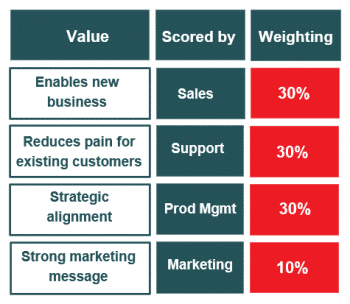
I was recently catching up over coffee with a product manager who attended one of our product management training courses a couple of years ago.
He told me about the success they are having with a roadmapping prioritization process that he learned about on our course.
Ian Threadgold is Head of Product Management at a growing SaaS company called Kallidus. They provide software products for enterprise customers to support their Learning and Development (L&D) and Human Resources (HR) functions.
“Last year one of my big headaches was trying to get agreement on what we put on our roadmaps. Everyone had a view. Some had very strong opinions. Trying to get agreement across all the different stakeholders was a nightmare.”
“It was really tough because priorities kept changing day by day. It depended on the latest sales deal, a major support issue or something we had promised on a previous roadmap. So the roadmap was constantly changing which lost us credibility with customers and made it impossible for Development.”
So Ian introduced a version of our roadmap prioritization process into the business.
Each key department, Sales, Support, Product Management, and Marketing, get a say in scoring new ‘candidate’ ideas that are put forward for the roadmap. The scoring is from 0 to 5, with 5 being the highest. They can all put forward any ideas they have at any time.
Sales might come back from the latest customer discussion with a candidate feature that they believe will clinch a deal. They propose it and so might score it with a 5. Then each of the other departments needs to score it as well. Using the pre-agreed weightings Ian can work out a final score.
“We use these scores as part of our quarterly planning cycle. We pick off the candidates with the highest scores from the top of the backlog and lock them into the next quarterly roadmap. Once this is agreed it can’t be changed and Development knows they can get on with them. We use 2-week sprints so that’s 6 sprints per quarter. We like to think of each quarter as a giant sprint.”
Ian went on to say …
“Now we have a process that involves all the key stakeholders. It’s transparent, so instead of us just saying we think it’s a good idea, everyone can see the logic that’s used to come to a decision. It’s made our lives so much easier. And interestingly we’ve ended up doing the stuff we expected to do anyway.”
But it’s not always straightforward. Sometimes stakeholders try to change the weightings to get something that they think is really important onto the roadmap.
“To begin with we had a bigger weighting for new sales because that’s what was really important for the business. But now as customer retention is becoming more important we’ve increased the Support weighting to 30%. The Marketing score was added as they need cool stuff to be able to talk about in the market.”
When I asked Ian why he was so pleased with the process he said…
“It feels like we’ve got to a nice compromise between the Waterfall and Agile way of working. Things are clearer, we get less hassle as everyone from the CEO down has bought into the process and we’ve regained control of the roadmap.”
More info on roadmaps …
There are various ways of doing this prioritization process. The one we teach on our training course also includes some scoring for the cost to the business. Please read our Product Management Journal on Roadmaps to learn more about the process and other aspects of roadmapping best practice – including our 5 steps to creating a perfect Roadmap.
If you want to find out more about Roadmap best practice or any area of product management why not check out our training courses.
Ian Lunn
Director, Product Focus


Join the conversation - 4 replies
Interesting blog post. I’ve had a few similar prioritisation processes but where I’ve struggled is how to stop people gaming the system by using tactical votes or breaking the system by just voting everything a 5 (or a 1)? My current preferred variant on this is to take a leaf out of Scrum and give each team a number of votes based on the Fibonacci number sequence (1,2,3,5,8 and 13) and they have to vote on the projects or features on offer using one of their numbers each.
Hi Martin. You could work with a variant, where you assign a fixed budget per stakeholder (in accordance with the weightings).
Let’s say Sales, Support and Prod Mgmt have 30 points to give to a list of 60 items (Marketing 10 points). They can give 12 items 5 points or 30 items 1 point and every variation in between. The stakeholder really has to make a choice.
You will need some calculation & fine-tuning to figure out what amount fits your situation, depending on the number of items on the backlog & the number of items delivered / sprint.
Tools like this are useful to get the guns pointing outwards to win in the marketplace rather pointing inwards and shooting each other with internal politics. It also helps in organizations that work virtually where branch office colleagues dont get to have water cooler conversations. Good post.
But how do you do this when you work in a completely incompetent business where you have no certainty about what happens in 3 months time? I can’t even get senior managers to care about the people impacted by this uncertainty, I doubt I can get them to care about planning the products future.